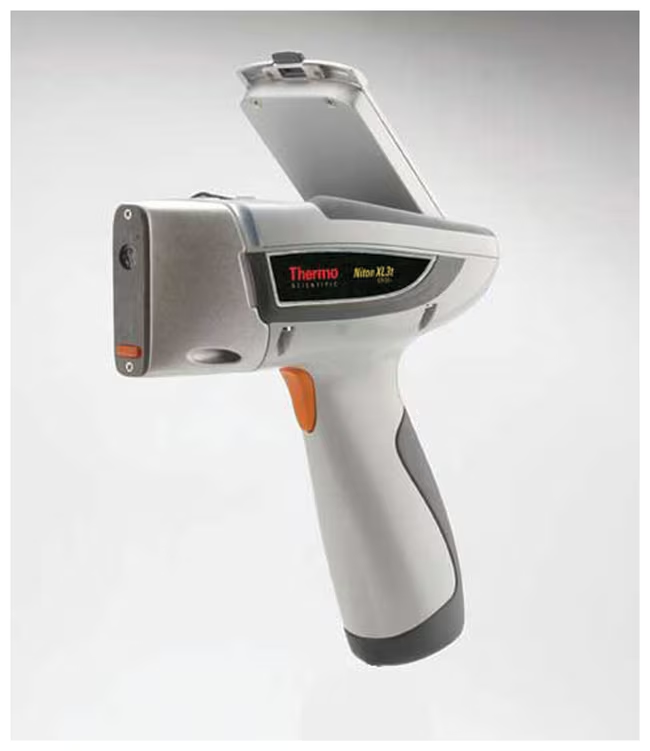Portable X-ray Fluorescence (pXRF)
Thermo Scientific Niton Gold XL3T Handheld X-ray Analyzer
X-ray Fluorescence (XRF) is a non-destructive analytical technique that is routinely used to obtain “bulk” analyses of materials (e.g., rocks, soils, ceramics, metals). The advantage of using XRF is its relative ease of use, rapid acquisition of data, and low cost. As with other X-ray spectroscopies, atoms in a material can be excited under a high energy beam to produce secondary X-rays with characteristic wavelengths. The X-ray beam cannot be focused to the same extent as an electron beam, so the sampled volume is relatively large (thus producing a “bulk” analysis).
The XRF instrument maintained at ICAL is a Thermo Fisher Scientific Niton Goldd++ Handheld X-ray Analyzer hand-held or portable instrument (pXRF) that uses an EDS detector rather than a WDS detector that is more commonly a component of desk-top or stand-alone XRF instruments. This provides very rapid analysis for all elements heavier than Na (Z>11).

The instrument is best used in the dedicated test stand, but it also can run on a battery pack in remote settings for in situ analyses. It can also be used to analyze materials that may have irregular shapes that cannot be destroyed in sample preparation such as archeological, paleontological and art materials.
Uses of the pXRF:
- Provides rapid bulk analysis of materials such as rocks, fossils, ceramics, metals/alloys, liquids
- Can detect all elements with Z>11 (Na and lighter elements cannot be detected)
- Detection limits are on the order of ppm for most elements
- Data acquisition can be very rapid. The acquisition mode is programmed to scan 4 different wavelength intervals for 30 seconds each, so a total analysis takes as little as 2 minutes. Longer counting times can be programmed to enhance counting statistics, particularly to look for trace elements just at the detection limits.
- The entire X-ray spectra are preserved in the metadata which is sometimes useful if there are issues of possible peak overlap.
- The metadata also include a photo image of the analyzed area which is useful when analyzing composite materials with different compositional domains (rocks, select areas on an artefact, etc.).
- Sample preparation:
- Powdered samples are recommended (crushed in a shatterbox, ball mill, or agate mortar and pestle; sieving to uniform size is recommended; and then packed in Teflon cups). Fluids can also be analyzed using Teflon cups in the test stand.
- Irregular objects such as art artefacts and archeological samples can be analyzed . pXRF has been used in many forensic studies of materials to establish provenance or authenticity.
- The battery pack also allows in situ analysis of materials in the field (e.g., outcrops, soil samples, drill core). This is useful to provide a guide to sampling in the field e.g., to look for elemental anomalies in drill core, to identify metals/ore in mineral exploration, to locate units that may have a high concentration of minerals used for age dating (zircon), etc.
- pXRF data should be considered to be semi-quantitative. pXRF is best used for reconnaissance samples to demonstrate the presence (or absence) of elements of interest and their relative abundances. In general, pXRF data are accurate to within +/-5%.
- Standards-based pXRF analyses will help improve overall accuracy of Post-acquisition
empirical corrections can be applied by applying working curves created by plotting
counts/concentration (wt% or ppm) for a series of standards for each element. See
the attached spread sheet for examples. ICAL has a number of standards available
from NIST and USGS to create additional working curves if the spread sheet does not
address element(s) you are interested in.
- If quantitative elemental analyses are needed for your research (e.g., for thermodynamic modeling, etc.), use the pXRF as a preliminary test to identify elements present, and then use either WDS-based XRF or ICP methods to obtain highly precise and accurate data.
- Typically, numerous spots are obtained for a given sample to demonstrate precision. For example, three analyses are typically acquired for a given powdered sample packed in a Teflon puck, and with readjustment of the sample in the Test stand in between analyses. Average or range of analyses can be reported.
- Instrument software has built-in routines that are optimized for soil or mining applications.
- pXRF data can be exported into Excel spreadsheets for subsequent graphical representation or statistical analysis.

